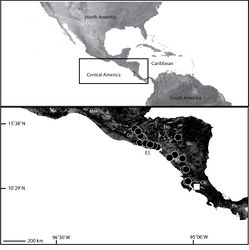Selenops oricuajo
| Notice: | This page is derived from the original publication listed below, whose author(s) should always be credited. Further contributors may edit and improve the content of this page and, consequently, need to be credited as well (see page history). Any assessment of factual correctness requires a careful review of the original article as well as of subsequent contributions.
If you are uncertain whether your planned contribution is correct or not, we suggest that you use the associated discussion page instead of editing the page directly. This page should be cited as follows (rationale):
Citation formats to copy and paste
BibTeX: @article{Crews2011ZooKeys105, RIS/ Endnote: TY - JOUR Wikipedia/ Citizendium: <ref name="Crews2011ZooKeys105">{{Citation See also the citation download page at the journal. |
Ordo: Araneae
Familia: Selenopidae
Genus: Selenops
Name
Selenops oricuajo Crews, 2011 sp. n. – Wikispecies link – ZooBank link – Pensoft Profile
- Selenops bifurcatus Muma, 1953: 20, fig. 35 (misidentification: ♀ only).
Type material
Holotype female: Oricuajo, Costa Rica, Biolley and Tristan (MCZ).
Etymology
This species is named after the type locality, Oricuajo, and is to be treated as a noun in apposition.
Diagnosis
Females can be separated from other species by the epigynum which has a conspicuous angular median septum located in the center of the epigynal plate, and by the epigynal pockets, and the internal ducts which have two branches (Figs 85–86). Males unknown.
Description
Holotype female: Color: carapace dusky orange with white setae; sternum light yellow; chelicerae same color as carapace, with dusky longitudinal lateral stripes and one dusky area in the center, not extending all the way to the top of the chelicerae; maxillae dusky yellow brown, darker on sides; abdomen dorsally grey to cream-colored with dark laterocaudal festoon; legs light yellow, darkening distally, with annulations on anteroventral faces of anterior femora. Carapace:0.95 times longer than broad. Eyes:AER nearly straight; PER recurved; PME larger than AME, PLE largest, ALE smallest; eye diameters, AME 0.15, ALE 0.03, PME 0.18, PLE 0.30; interdistances AME-PME 0.10, PME-ALE 0.28, ALE-PLE 0.30. PME-PME 1.00. ALE-ALE 1.83; ocular quadrangle AME-AME 0.38, PLE-PLE 1.80. Legs:leg formula 4321 (Muma, 1953); spination not available, legs completely disarticulated. Mouthparts:chelicerae with stout setae medially and anteriorly; maxillae longer than broad, with tuft of conspicuous setae distally; labium distally rounded. Abdomen:without terminal setal tufts. Epigyne:angular to quadrate median lobe, truncate posteriorly, epigynal pockets present, genital openings located at anterolateral margins of median lobe; internally, ducts large, branching into two heavily sclerotized lateral branches, fertilization ducts located posterolaterally and directed posteriorly, small posterodorsal fold present, does not cover ducts (Figs 85–86). Dimensions: Total length 10.45. Carapace length 3.60, width 3.80. Abdomen length 6.85, width 4.65.
Natural history
All that is known of this species' natural history is that it has been collected with Selenops bifurcatus.
Distribution
Known only from the type locality (Map 8).
Original Description
- Crews, S; 2011: A revision of the spider genus Selenops Latreille, 1819 (Arachnida, Araneae, Selenopidae) in North America, Central America and the Caribbean ZooKeys, 105: 1-182. doi
Images
|

